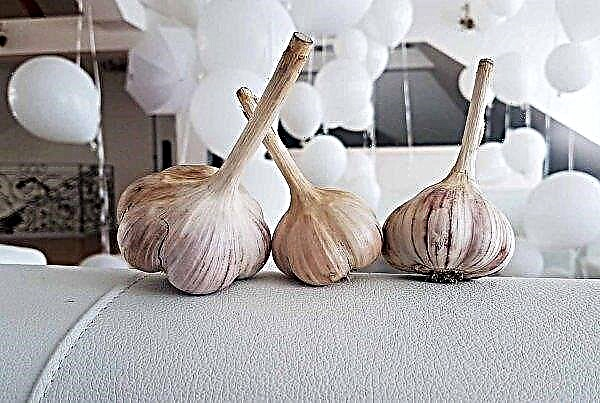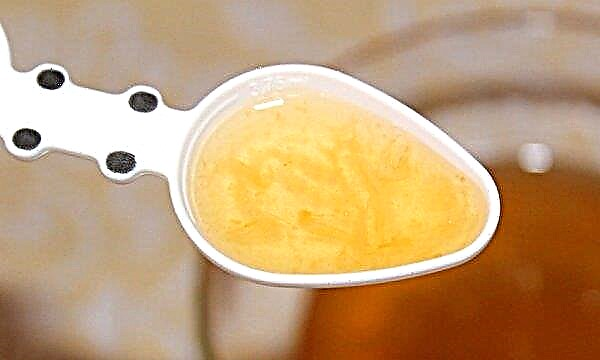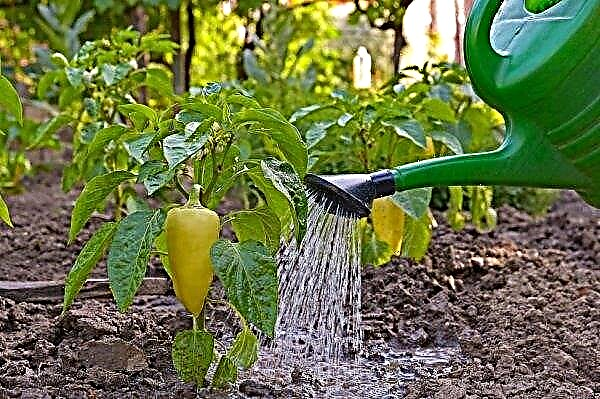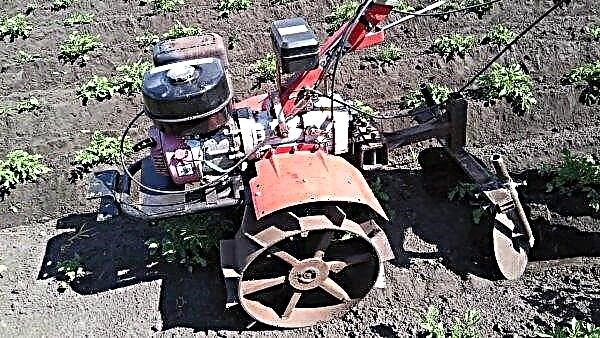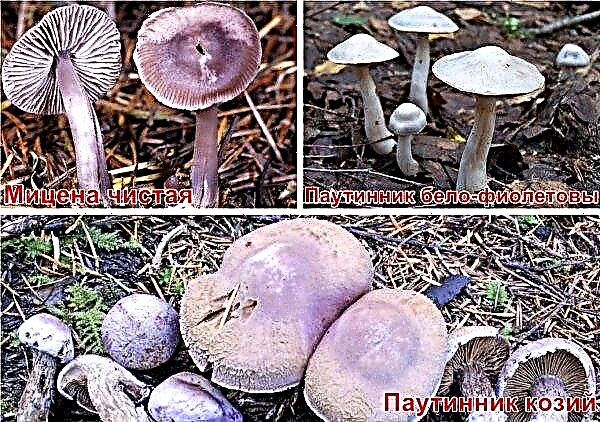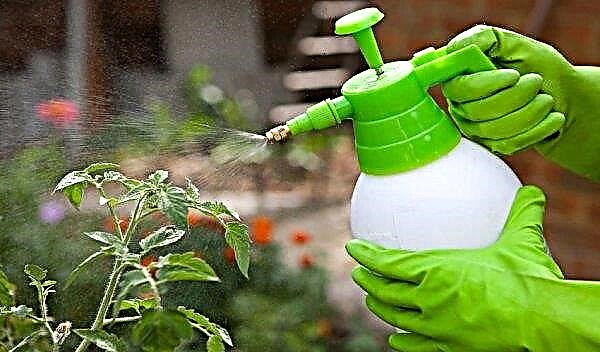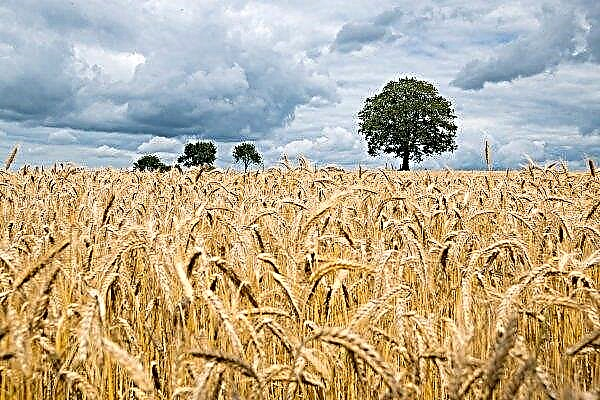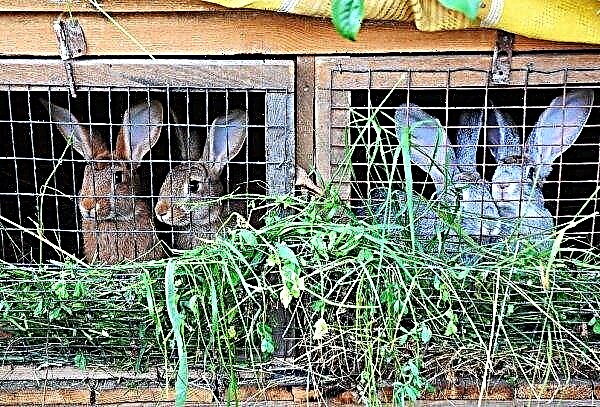The Kiparisov family has long conquered the most sophisticated gardeners in creating landscape designs on personal plots, in urban park areas and squares. Rock juniper has become one of the favorites. The plant has a wide variety of decorative varieties. It is easy to grow and care for it.
Botanical Description
In the natural habitat, rock juniper grows on the slopes of mountains and rocks at an altitude of 1,200–1,700 m above sea level and grows up to 10–18 m. The trunk is in a girth of 0.8–2 m in diameter. North America is considered to be the homeland of the tree. Dwarf varieties are much smaller in size of wild forms of juniper, and reach a height of up to three meters.

The following common botanical signs are characteristic of rock juniper:
- conical irregular crown is formed immediately from the base of the trunk, over the years it becomes rounded;
- leaves with opposite plates, similar to scales, ovoid-rhombic in shape, length 0.2 cm, diameter 0.1 cm;
- bark of red-brown or brown color;
- the color of the foliage is dark green, gray-blue and green-gray;
- needle-shaped coniferous leaves 1.2 cm long, 0.2 cm wide;
- young stems of a pale or green-blue color;
- fruits are round cones of dark blue color 4–6 mm in size; by the end of the 2nd year, seeds with a diameter of 5 mm of red-brown color ripen in them.
Dwarf shrubs of the Cypress family have their own unique decorative characteristics that adorn any landscape with their lush crowns of various green-blue shades.Did you know? Juniper exists on the planet for approximately 50 million years.
Video: Juniper rocky
Use in landscape design
The needles of various shades and the crown of various shapes perfectly harmonize with other cultures as a background plant in any gardens. They are used for planting in both single and group compositions in combination with masonry, in alpine, heather and Japanese style gardens.
Did you know? For the first time, the ancient Egyptians began to use juniper as a medicinal plant, later the Greeks and Romans.
A tree is planted along the line of alleys in the form of a dominant, growing vertically in the center of a flower bed. Fits into almost any style of designing a personal plot (English with strict restraint, Scandinavian minimalism).
Plant a plant as living fences, make out passages, openings or divide the space into sectors. The geometrically clear and regular shape of the crown looks impressive in any composition.
 1- juniper rocky Blue Arrow; 2 thuja western Smaragd; 3- Juniper Cossack Mas; 4- Juniper Lime Glow; 5- Juniper Blue Star; 6- Japanese Spirea Goldflame; 7- Mountain pine Pumilio
1- juniper rocky Blue Arrow; 2 thuja western Smaragd; 3- Juniper Cossack Mas; 4- Juniper Lime Glow; 5- Juniper Blue Star; 6- Japanese Spirea Goldflame; 7- Mountain pine Pumilio
Popular varieties
American breeders have bred many varieties of juniper rocky, which is widespread in landscape planting around the world, especially in middle latitudes. The most suitable varieties for our climate are described below.
Blue Arrow
Blue Arrow is an evergreen shrub that grows from 1.5 to 2.5 m. It attracts with a good survival rate and a beautiful crown of gray-blue metallic tide. Needle-shaped scaly needles. It has a narrow columnar shape with branches tightly adjacent to the trunk, reaching a diameter of 50 cm. It has good drought tolerance and frost resistance (-34.4 ° C), but does not tolerate polluted city air.

Blue Heaven
Blue Heaven has a more disheveled pyramidal crown, reaching one meter in diameter. The shoots are cylindrical raised. The average height of the tree is 2 m. Annual growth is 20 cm in height and 5 cm in width. Does not change the blue color of needles with steel tint throughout the year. Cones are dark blue with a gray coating. Photophilous, tolerates light partial shade. It is unpretentious to soils, wind-resistant, has high winter hardiness up to -28.8 ° С.
Fisht (Fischt)
The coniferous handsome Fisht grows up to 10 m. It is undemanding to the ground, frost-resistant up to -34 ° С. The crown grows almost from the ground, the conical shape is irregular. Dark green needle needles with tight-fitting scales grow to 1.2 cm.
Fruits - cones of dark blue color with a diameter of 4-6 mm with a bluish coating. Photophilous variety, but can tolerate slight shading. Gas- and smoke-resistant, well takes root in the city.

Wichita Blue
After 10 years, the slow-growing dwarf shrub grows only up to 40 cm tall, but the compact pyramidal crown grows magnificent - up to 1.5 m in diameter. Branches open with blue needles, which beautifully casts silver. Winter-hardy variety (up to -34 ° C), tolerates shade well, but it is better to plant it in a sunny place. Tolerates urban climate, resistant to harmful emissions.
Moffat Blue
The height of the coniferous plant is impressive for decorative planting. The second Latin name is Juniperus Scopulorum. It grows up to 3 m, and the broad-pyramidal crown - up to 1 m in diameter. Green-blue needle needles 12 cm long.
Important! Tall varieties of juniper need to be planted in a substrate rich in nutrients. Dwarf bushes are transplanted into sparse soil.
The bark is reddish brown. Spherical cone berries of a dark blue color with a diameter of 4-6 mm. Very winter-hardy variety (-29 ... -34 ° С), photophilous, in shady areas the crown is exposed. Does not tolerate humid climate, gas and smoke resistant.
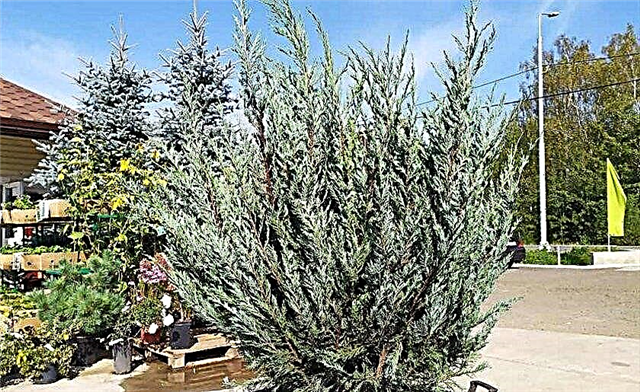
Landing Features
The landing area must be selected spacious with good lighting. Seedlings with closed roots are allowed to transplant in any season of the year. With a bare root system, they are moved to open ground in early spring, when the soil is already well warmed up.
For planting, they dig a hole twice as large as the rhizome of the seedling. Previously, 20 cm of a broken brick or crushed stone are poured into the recess. A bush is placed in the prepared place and sprinkled with a mixture of peat, sand and turf land (2: 1: 1). The root neck should be flush with the ground. Freshly planted shrubs are abundantly watered with two buckets of water.
At what distance to plant from each other
Seedlings take root well when they are spacious. The distance between undersized varieties should be at least 50 cm, between the "giants" - 2 meters.
Creeping species are planted even further from each other, as they greatly grow across. In order for them to form a dense carpet, the distance between the bushes should be 1–1.5 m.
Seedlings preparation
Before lowering the roots of the plant into the ground, they are recommended to withstand 2 hours in a bucket of water. Adult seedlings (from 4 years old) are grown in nurseries, but they are more difficult to plant, since they do not take root in another substrate as quickly as young ones.
Before planting the bush in open ground, the root system with an earthen lump is kept for 2 hours in a bucket of water. The open roots of seedlings are recommended to be treated with root stimulants, for example, “Kornevin”.
Proper plant care
All varieties of juniper rocky are unpretentious in care, many of them withstand frosts and the polluted atmosphere of cities. Despite this, they still need simple care: sparse watering, pruning, top dressing, and protection from diseases and pests.
Young seedlings must be sheltered for the winter. In the first few years after planting, plants are not marked by rapid growth. Only by 10 years of life, trees actively give rise to growth.

Watering and fertilizer
Adults irrigate water three times in the summer season and additionally during a period of severe prolonged drought. Young shrubs are watered every evening. However, you can not "go too far" with moisture - it is harmful to this culture. It is enough to pour 10-30 liters of water under the root of the plant, depending on the variety.
It is strictly forbidden to fertilize the plant with organic fertilizing. Infusion of mullein or bird droppings will burn the root system, other natural organics are a source of nitrogen, which reduces the tolerance of low temperatures in juniper crops. Young seedlings of the Cypress family fertilize 1 time from April to May.
And that’s enough for them. Kemir-universal (20 g / 10 l of water) or nitroamafosku (30–40 g / 1m2) is used as top dressing. Bushes that have taken root well do not need to be fertilized. Adult plants are fed once every two to three years.
Did you know? If the juniper is dreaming, expect a happy change, good luck in business, wealth.
Mulching and cultivation
When the landing is completed in the open, carry out trunk mulching to prevent freezing of the roots (layer thickness 8 cm). Use sawdust, pine bark, wood chips or peat.
Shallow loosening is carried out for young plantings, which is carried out after weeding the weed grass and watering. Heat-loving varieties should be mulched for the winter. In early spring, the layer of mulch is raked so that the root neck does not rot.
Pruning
Pruning for this coniferous crop is an optional process. It is performed for decorative purposes to shape the crown. Dried or damaged branches still need to be cut. The procedure is performed before the sap flow in March.
Wintering
The tree tolerates frosts well without additional insulation. To prevent branches from breaking under the pressure of snow, they must be pressed to the trunk with strapping material, such as ropes or twine. This is especially true for varieties with a spreading crown. Only young seedlings need to be covered with non-woven material or spruce branches.
Important! If the juniper transplant is not carried out correctly, the plant may die due to damage to the rhizomes. Especially carefully you need to transplant adult large trees 3-4 years old.
Diseases and Pests
Among the most common diseases and pests are the following:
- Fusarium wilt (tracheomycosis). There is a disease from waterlogging of dense soil. A fungus grows on the roots, which grows inside the vascular system, which leads to its death. As a result, the nutrition of the aerial part of the bush ceases. As a result, shoots in the upper part dry up. In this case, the affected branches are cut off to prevent the spread of tracheomycosis. The topsoil should be changed to fresh. Wood and earth are sprayed with fungicides, for example, "Maxim", "Quadrice", "Fitosporin-M".

- Rust. Bright orange growths appear on the branches of the shrub. Gradually, the branches dry out. Affected by a fungal disease, juniper quickly loses its decorative beauty. Sick branches are cut, and the plant is completely sprayed with fungicides. The Vektra, Rogor, Tilt, Bayleton and Skor funds have proven themselves well.

- Drying out of branches. A disease that kills a bush. The needles turn yellow and crumble. At the stage of active development, the disease germinates with fruiting bodies on the bark and needles. The yellowed foliage is cut completely, and the bark and the whole plant are treated with fungicides (Skor, Riomil Gold MC and Tilt).
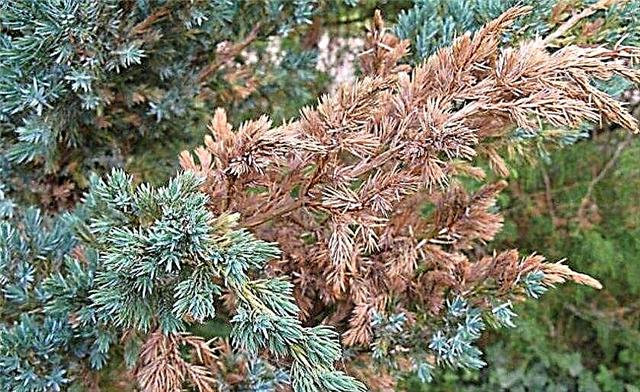
- Brown shute. The signs of the disease are obvious: yellowed leaves appear, which fall strongly, and fruit ellipsoid bodies form on the needles at the end of summer. Brown shute appears when the coniferous crop suffers from the shade and dampness of the soil. Sick branches are cut to healthy sites and sprayed with fungicides “Strobe”, “Quadris”, “Skor”, “Riomil Gold MC”.
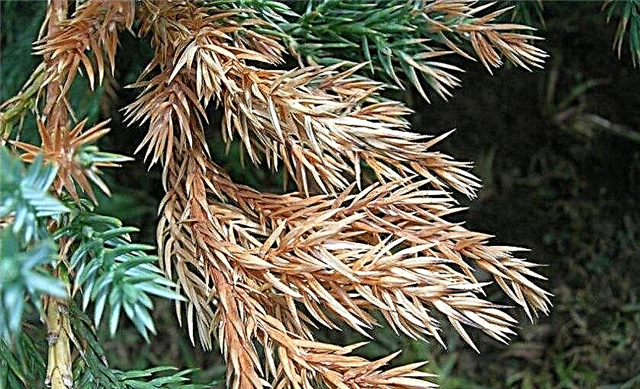
- Of the pests, most junipers are affected by mining moth, aphids, scabies, spider mites. From the moth use "Decis" (2.5 g per 10 liters of water). The aphid perfectly perishes from the Fitoferm solution. Ticks are removed with acaricides such as "Actar", "Actellik", "Karbofos". Scarves are disposed of by “Karbofos” (70 g / 10 l of water). They completely process the entire plant and the soil around it. When fighting insects, they irrigate insecticides not only the crop, but also the soil near it.

Breeding
It is better to propagate juniper varieties in three ways:
- Layering. The method is used for creeping forms. They clean the stem from needles and fix it on the surface of the soil near the trunk circle. Rooting takes place completely from 6 months to a year. Rooted cuttings are cut from the original planting material and transplanted to grow in the area with a slight shadow.
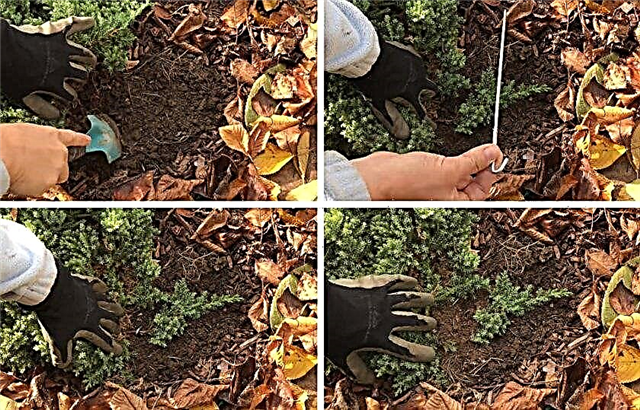
- Cuttings. The material is harvested in the spring. Cut off the apical shoots with the heel (part of the branch from which the shoot grows), if they are half-lignified. Cuttings are placed in greenhouses when they take root, planted in a permanent place. The process can last 1.5-6 months.

- Vaccinations. This method is quite troublesome and is carried out by professionals. They propagate mainly valuable varieties.
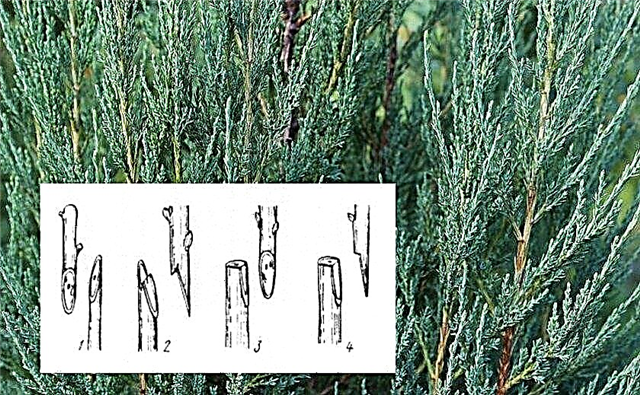 1 - simple; 2 - improved with a tongue; 3 - butt; 4 - with a saddle
1 - simple; 2 - improved with a tongue; 3 - butt; 4 - with a saddle








 1 - simple; 2 - improved with a tongue; 3 - butt; 4 - with a saddle
1 - simple; 2 - improved with a tongue; 3 - butt; 4 - with a saddle